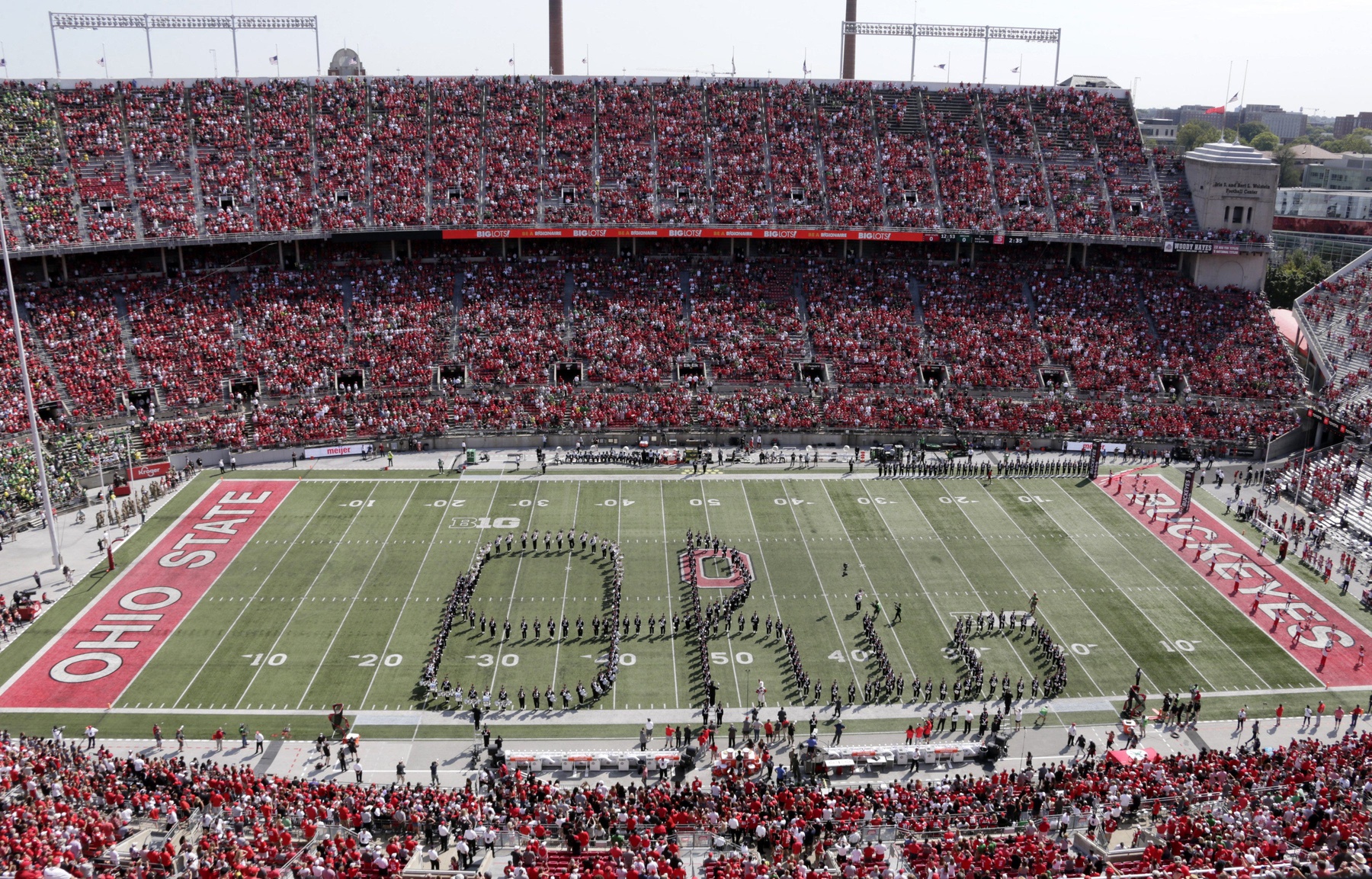The Ohio State football program has been around since 1890 and has been home to a number of great traditions. Within the realm of college football, tradition is what sets the sport apart from all others. The pageantry, spectacle, and passion are unmatched. Ohio State football traditions are no exception.
When one looks at the history of Ohio State football, “winning” could be considered a tradition. In fact, depending on where you look, Ohio State has the highest winning percentage in history. Only Michigan outlets have the Wolverines edging out the Buckeyes at the top (for now), so take most numbers with grains of salt. The NCAA still officially counts pre-WWI matchups with local YMCAs and high schools as wins.
Regardless of the opinions surrounding “real” wins or claimed National Titles, there are plenty of Ohio State football traditions worth knowing as the 2024 season is right around the corner.
The Best Ohio State Football Traditions
Buckeye Grove
Across Ohio State’s long history, it has produced plenty of high-level talent. In addition to taking home seven Heisman Trophies — two of which were won by Archie Griffin, the award’s lone two-time winner — the Buckeyes have had 93 consensus All-Americans. To this point, 216 Buckeyes have been named to at least one First-Team All-American list by any of the five reputable organizations.
In 1929, Buckeye Memorial Grove was established by the Scarlet Key, a group of football team managers. The Scarlet Key wanted to provide a sustainable way to honor those among the elites in college football. And thus, they planted the first 11 trees in a football formation.
Since then, Buckeye Grove has grown to what will be 216 trees once Marvin Harrison, Jr.‘s second tree gets planted before this year’s Spring Game. When Urban Meyer took over the program, he established a secondary tradition. Whichever team loses the Spring Game would be the ones to take care of Buckeye Grove and add mulch.
A fun fact about Scarlet Key: the group went around to opposing campuses and planted Buckeye trees.
Script Ohio
In 1932, in the 29th edition of The Game, the University of Michigan Marching Band marched out to form the word “Ohio.” Four years later, Ohio State Marching Band director Eugene Wiegel debuted an improved version during the game against Pitt.
Instead of just marching out and forming the word, Wiegel had his drum major literally lead the band through a cursive form of the word. This decision was made not due to stylistic preferences but rather logistical. Marching band charts as we know them today were not available at the time.
It’s perhaps one of the most iconic not only Ohio State football traditions but within college football as a whole. And, in time, it grew. “Dotting the i” turned into its own tradition. While it has become the role of a sousaphone, the first-ever “i-dotter” was a trumpet player. Every now and then, the band will have an honorary dotter. The likes of Woody Hayes, Earle Bruce, Jack Nicklaus, and Bob Hope have taken over.
As the band grew, so did the tradition. The first iteration of the Double Script Ohio was in 1966. On Homecoming with the alumni, the band breaks out the Quadrupal Script Ohio, thus maximizing the most iconic of the Ohio State football traditions.
The Buckeye Leaf
While the gray helmet with the scarlet stripe down the middle is iconic and well-known, there’s something about seeing a player’s helmet covered from front to back in buckeye leaves.
Hayes’ 1968 team was on the brink of a National Championship. Team trainer Ernie Briggs suggested a kind of pride sticker to help motivate the club. Hayes obliged, the team went unbeaten, won the title, and the rest is history.
The specific criteria for a player to earn a sticker is a trade secret. The most common ideas are stickers for wins, explosive plays, and overall dominant performances. Back in the Jim Tressel era, players had to grade out to a certain percentage in film to receive a sticker.
The uniformity of the tradition is a great touch as well. There is a specific order in which leaves are placed on the helmets, starting with the back of the left hemisphere of the helmet. The stickers do not infringe on the stripe, either. There are fewer things better than watching a playmaker’s helmet get more and more full as the season rolls on.
Gold Pants/TheGame
There’s one game in college football that needs no special name or overly theatrical moniker, just “The Game.” Ohio State versus Michigan. It’s a rivalry like no other that has produced, to this point, 20 claimed National Championships, 84 Big Ten titles, 10 Heisman Trophy winners, and 1,968 combined wins (for now).
The feeling of Ohio State toward “The Team Up North” cannot be quelled by a win. Some Buckeye fans want Michigan to be 11-0 at the time of The Game so that Ohio State can ruin the Wolverines’ season. Others would rather Michigan lose every game and end up relegated to the MAC.
The two have faced off 118 times. Ohio State currently trails in the series, 51-61-6 thanks to a 0-13-2 start to the rivalry prior to the end of WWI. The Buckeyes got to within seven before the recent embattled three-year run.
Back in 1934, first-year coach Francis Schmidt was staring at the Buckeyes’ 6-22-2 mark against the Wolverines. He told his team that “they put their pants on one leg at a time just like everyone else.” Thus, Schmidt’s team won 34-0 and kicked off the program’s first four-game winning streak. Following each win over Michigan, every player receives a pair of gold pants on a chain to commemorate.
Ohio State often measures its success as a program and on an individual level based on the number of gold pants. C.J. Stroud was a fantastic quarterback both for the Buckeyes and in the NFL in his rookie season. Unfortunately for him, he left Ohio State with as many pairs of gold pants as he did coming in. Some within the fanbase put Stroud below less-talented quarterbacks like, say, J.T. Barrett who earned five pairs, four as a starter.
Shedding the Black Stripe
In what is the newest of the Ohio State football traditions, the black stripe is all about a player earning their keep.
In 2011, Coach Meyer decided to start up a tradition of his own. Many things could be said about Meyer as a college coach and probably just as much as an NFL coach. One thing is certain: he loved Ohio State football. Despite the fact that he, as head coach, could hand-pick his roster, he believed all newcomers to the program had to earn their way. Thus, he had a black stripe placed on the scarlet stripe on the players’ helmets. That stripe would remain on the helmets until such a time Meyer and his staff believed the players earned their spot.
To date, Ryan Day has continued the tradition and it’s become a good way of seeing which true freshmen will be immediate contributors. Last year, Carnell Tate was the fastest to have his black stripe removed after just five spring practices. This year, Jeremiah Smith, the top overall recruit in the 2024 recruiting cycle, shed his in four.
Hear The Victory Bell
On October 2, 1954, Ohio State beat Cal, 21-13, and a new sound rang across campus. The Classes of 1943, 1944, and 1945 donated a 2,420-pound bell to the southeast tower of Ohio Stadium. Members of the Alpha Phi Omega Fraternity ring the Victory Bell after every single Ohio State win.
According to legend, the ringing of the bell can be heard five miles away on a clear day. To date, the bell has rung 631 times including 430 Big Ten wins, 31 Big Ten titles, and seven National Championships.
There are plenty of Ohio State football traditions that occur on a weekly basis but the ringing of the Victory Bell is the cherry on top of a successful day in Columbus, Ohio.







